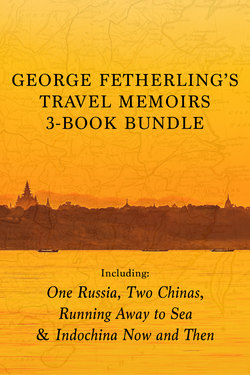Читать книгу George Fetherling's Travel Memoirs 3-Book Bundle - George Fetherling - Страница 23
На сайте Литреса книга снята с продажи.
— THE VIEW FROM PHU SI —
ОглавлениеEveryone enjoys going to Luang Prabang, which is a UNESCO World Heritage site, and justifiably so. It is perhaps the best-preserved fully functioning ancient city in Southeast Asia. It sits, with a generalized air of gentle timelessness, perched along an especially beautiful stretch of the Mekong. Luang translates as Royal, as this small city (the population has merely doubled in the past century and a half) was the first seat of the original Lao Kingdom, the Lan Xang. That was in 1357. When the administrative functions were moved downstream to Vientiane in 1545, it became a sort of city-state while remaining part of the kingdom. But it became a kingdom in its own right in 1707 when the Lan Xang splintered into three parts. It held that position, with a couple of embarrassing interregna, until the Pathet Lao formed the present republic in 1975.
Northern Laos was one of the last pieces the French needed to complete their Indochina jigsaw puzzle. They hovered nearby as the puny kingdom was raided and robbed by the Burmese, the Siamese, and the Vietnamese. Then in 1887, the Pavillons Noirs came pouring down the Nam Pa, which flows into the Mekong from the east a few kilometres north of the city. The attack was so devastating that the king had to bargain with France for permanent protection. The French allowed the monarchy to remain, intact and essentially powerless, inside the palace (now a museum).
One of the first French initiatives in Luang Prabang was to put up a building called the Commissariat. In a city characterized by smallish two-storey hybrids (French brick at street level, Lao wood construction up above — most dating from the Postcard Age, with a few from the 1950s), this was a big structure indeed. These days it has been rebuilt beyond recognition and is the forty-room Phousi Hotel, where M and I were staying. It is just down the road from the Hmong market on Thanon Setthathilat, the long street distinguished by the sorts of businesses that Westerners favour: a foreign-language bookshop, a highly calorific bakery, an Internet café, and so on. There can be few such high streets in Southeast Asia less severely marred by tackiness and hucksterism.
Craft items are the main draw in the stalls at the Hmong market, particularly clothing and accessories. There are trousers and square tops made of hemp cloth, perpetuating traditional motifs in startlingly bright colours along with black. The batik work is of high quality, but then dyeing is a Hmong art form, as with indigo skirts (ones actually made by boiling the indigo plant) that are then decorated with red. All girls are taught needlework (paj ntaub, literally “flower cloth”) from an early age. By puberty they have already amassed the wardrobe that is to carry them along in married life. The Hmong are wild about elaborate hats and wide-strapped shoulder bags with mythological designs, both of which look rather Tibetan in character to Western eyes. They are also avid fans of jewellery, including finely made necklaces and bracelets fashioned from ropes of silver rings.
There were some staple foods for sale at the Hmong market, as well: rice of course, maize, cane, peanuts, green beans, squash, cucumbers, and an edible root called manioc. But the main farmers’ market is elsewhere and operates in the early mornings. It is an orderly assemblage of people buying what they need for the evening table. By contrast, the night market, down by the waterfront, is more Chinese in character, in that it’s jam-packed with sharp-elbowed bargain hunters straining their eyes under the strings of electric lights to determine, by feel and by smell, the best possible example of each species of fish while, at the same time, arguing or gossiping with everyone else in the crowd.
The city always has been and continues to be the spiritual centre of the country. Most of it sits on a thumb-shaped peninsula, in the middle of which is a single, large hill — in the circumstances, one might almost say a miniature mountain — called Phu Si. This is home to four of Luang Prabang’s thirty-three surviving temples, some of them five hundred years old. They vary considerably in their architecture. One can only imagine what the city was like before the French takeover, when there were sixty-six temples.
One climbs Phu Si by a long series of steep steps on the west side. For some, this walk is related to religious observance of course; for others it is a matter of sightseeing. Going up to the summit was one of the first things we did on arriving, for we wanted to take in the 360-degree view before the light faded. At the peak, where in another culture with a different history one might expect to find some sort of statue or memorial, there are instead the rusting remains of a Russian anti-aircraft emplacement. On the north side, one looks out over the Nam Kha far below, a wide smear of brownish water winding its way along toward its union with the Mekong. Running more or less parallel to it was the then still notorious Highway 1, which had recently experienced a resurgence of bandit activity. It was as though the ghosts of the Pavillons Noirs had not been put to rest, or were somehow being honoured.
